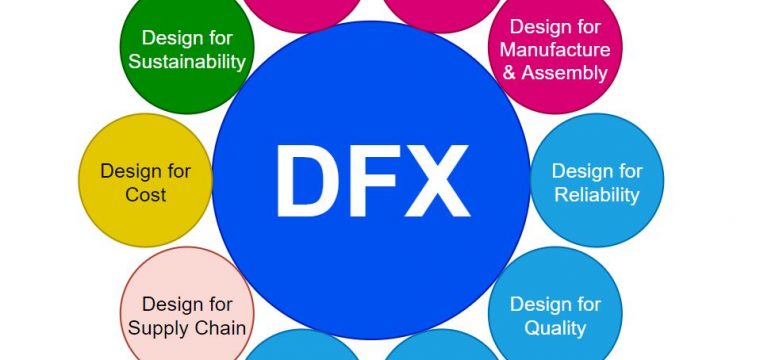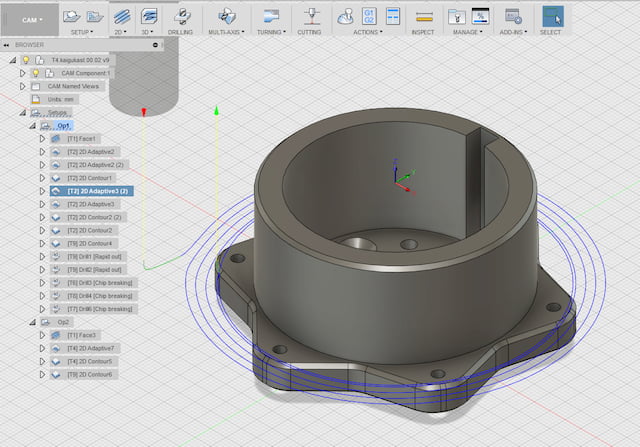Design for supply chain is a part of theDesign for Excellence (DFX)philosophy that focuses on creating designs that improve a certain aspect of a product. Some popular examples of DFX categories are Design for Manufacturing (DFM),Design for Assembly (DFA),可靠性设计(DFR),依此类推。
在这些类别中的每个类别中,设计人员都会添加功能和功能,以提高最终产品相对于某个属性,例如制造,组装等方面的易用性。万博客户端登陆
Design for Supply Chain is a similar offshoot of DFX. It is one of the most crucial design concepts in today’s market that manufacturers are trying to leverage for great payoffs.
This post aims to explain the benefits of seamless integration of the product design with the supply chain and provide pointers on how companies can harness the same. But let’s start from the beginning.
什么是供应链?
We can define a supply chain as a sequence of processes in a product’s life cycle, from the procurement of raw materials to the sale of a product. The four main elements are:
- Procurement
- Production
- Storage
- Distribution
我nitial design and development stages determine up to 80% cost of the final product. Aspects such as the amount and lead time of raw material/components, supplier location, standardisation of components, physical features and complexity of a product deserve attention in the initial stages for better operations management.
What is Supply Chain Management?
Supply chain management is the process of managing goods and services from the initial stages of manufacturing all the way up to providing after-sales services/warranty for a product.
A product’s design may be the very best in the market, but it may have high supply chain management costs due to poor operations management of its various elements. It is therefore prudent to start factoring in decisions for supply chain management as early as possible.
What is Design for Supply Chain (DfSC)?
Design for supply chain or DfSC is a discipline of DFX that provides practical techniques to optimise a product’s design to integrate it with the supply chain.
传统上,操作物流一直been an afterthought and their design comes much later in the product development process. This is because many companies fail to understand the role of product design in the supply chain.
Why do we need Design for Supply Chain?
研究表明,在设计阶段做出的决策对敏捷性,自定义策略,供应链和产品生命成本产生了相当大的影响。产品开发,制造,营销,采购,金融和供应链管理团队之间的平稳合作可以大大提高产品的价值,同时降低整体成本。
A well-thought-out DfSC strategy can improve responsiveness, supply chain visibility and communication, diminishing product costs, time-to-market and supply chain risks. All these benefits give a company an incredible competitive advantage over its competitors in the global market.
Design for supply chain proposes making changes in the design to improve the overall logistical efficiency of a product.
Design for Supply Chain Principles
DfSC techniques are an efficient tool to create a product that integrates well with the logistics system. While component and manufacturing costs still play an integral role in the total costs of a project, an optimum supply chain will have a major influence.
Thus, we list out different DfSC strategies to bear in mind in the product design phase that will influence the supply chain.
Use standard parts

Using standard parts in products instead of proprietary parts is advisable to maintain an uninterrupted supply of said parts. In the event that a supplier cannot complete an order, you can easily find another supplier.
Standard parts are also cheaper as their manufacturing is usually carried out on a larger scale.
Prefer pre-assembled parts
Many times, suppliers are capable of some preliminary assembly on their part. This reduces the assembly time in the company’s manufacturing process. This can be understood with a simple example.
假设产品由三个单独组件组成的组件制成。制造工艺设计可以使供应商仓库中的两个零件的组装在与第三部分的最终组件一起运送之前。
因此,即使第三部分迟到了,您可以在稍后在最后的组装上开始工作,您也可以通过让其他人为您做部分工作来节省时间。
Use your .STP files to get an instant manufacturing quote online
Quote in seconds
Short lead times
Delivery by Fractory
Prefer fewer sources
如果可能的话,限制用于制造零件的分包商的数量。通常,每个制造商都提供各种服务,但不涵盖项目的所有必要制造方法。
如果设计师知道这些限制,他可以在设计阶段牢记它们。
例如,如果组件仅需要另一个分包商制造的单个CNC加工部分(因为一个人照顾sheet metal fabrication不提供加工服务),最好至少尝试找到替代设计解决方案。
This way, you can keep the sources minimal, reducing points of contact and limiting the different logistical puzzles while lowering the stress on supply chain capabilities.
Another option is to make the supply chain/outsourcing manager aware of the requirements as early as possible. This means he has plenty of time to find a manufacturing partner to cover all the necessary requirements for the project at hand.
这也是我们分裂的原因,使供应商具有不同功能的供应商,以提供单一接触点的一站式解决方案,因为它减少了为每个项目找到合适的解决方案的困难,并最大程度地减少了供应量的压力万博客户端登陆连锁管理。
Prefer local
我f possible, make sure that your supply chain involves as many local manufacturing partners as possible. It doesn’t mean that you should always turn to your neighbour, but outsourcing to other countries for minimising costs can backfire.
This is especially evident in today’s world where the Covid situation has put a great strain on supply chains all over the world, with production lines sitting idle due to the shortage of certain parts.
Of course, the costs may be a lot lower somewhere else. But if you add the shipping costs, lead times (waiting also costs) and involved risks into the equation, it might often turn out that the cheaper face value may be easily be surpassed by the quickness and stabile nature of turning to local (at least in the same country).
控制加速货运成本
Expedited freight, commonly known ashotshot services, are often a major contributor to transportation costs. This cost, however, is controllable through smart product design and supply chain management. Critical parts for a product must be identified, and their lead times must be controlled for an uninterrupted supply.
The designers must also consider what alternate components could be used for manufacturing in the case of a shortage due to increased demand or diminished supply.
To prevent such an occurrence, the company must give the part suppliers sufficient lead times and demand forecasts well in advance. This helps them commit to more accurate delivery plans and avoid the need for expedited freight.
Product development teams must also consider the impact of any design changes on storage and transportation. Sudden, drastic changes that involve heavier components can create part scarcity and freight costs.
Plan for product evolution
Products evolve with time. Product designers must evaluate a product for potential modification in its architecture in the future and ensure these changes are supply chain friendly.
Some examples of such design changes are size variation, fragility, technology update and infrastructure upgrade. All these changes directly affect the logistics system and need careful planning and smooth execution for minimum disturbance to it.
Another helpful design tip to reduce the strain on the supply chain is to transition technology as soon as possible. A long drawn out transition strategy places an unnecessary burden on the chain to maintain inventory, service levels and supply of older components.
我f a technology is approaching end-of-life, strategists recommend proactively phasing out older technology and simultaneously introducing new technology.
Reduce inventory costs
库存是产品制造,组装和装运所需的组件总库存。设计决策会影响产品的库存水平。例如,设计成分较少的产品会导致份量较短。
减少交货时间使公司可以一次与较小的库存合作。
提高库存水平的另一个设计技巧是重新配置组件以替代用途。少量库存为公司在维护,存储和运输等领域中节省了资金。它还提高了灵活性,同时减少浪费和过时的风险。
Adopting the right supply chain design
产品设计teams (PDT) can contribute to the selection of the right supply chain management technique for the product by supplying relevant information and adopting various recommended practices during design.
This selection must be made with the company strategy in mind and not the attributes of each product. For example, whether the manufacturing process design is for high volume products (>10000/year) or low volume-high complexity products (10/year to 10000/year).
For high complexity products, greater customisation needs are customary and the design team determines the number of variants and the extent of each customisation. Due consideration must be given to the ability and feasibility of switching the supply chain type in the future if the need arises.
Cut down on warranty costs
Design teams can eliminate servicing and warranty costs to a large extent by building reliability and other relevant features into the product. These features that improve product quality will be costly to develop, but they will usually offset the much higher warranty costs.
PDT必须努力建立自我诊断功能,该功能可以提醒操作员在产品中的零件或功能故障,尤其是对于具有较高故障率的关键部件。这可以最大程度地减少服务调用的数量,因为用户可以更有效地进行故障排除。
Minimising warranty costs means the need to ship and store fewer parts and tools at service centres. The need for a wider distribution network also goes down.
Example of DfSC – The Design of an Aluminium Can

Let us discuss the design of an aluminium soda can to appreciate DfSC better.
Each year, approximately 180 billion aluminium soda cans move through their distribution network to reach consumers. The most common shape for these cans is that of a cylinder. But it wasn’t always so.
最初,建议许多不同的形状与当今如此受欢迎的圆柱形状一起存储饮料。由于该过程的规模巨大,产品设计的微小变化可能会成倍增加,并转化为巨大的成本或大量节省。
球形的想法可以首次提出around. A spherical can meant the lowest cost of raw materials, as they have the smallest surface area for a given volume. But they would only have a packing efficiency of 74%. 26% of space would be wasted during transportation and storage, even when spheres were packed as closely as possible.
This would increase logistics cost as fewer cans could be transported and stored at any given time and a greater number of trips would be needed. They would also be less stable and roll right off without much stimulus.
To maximise packing efficiency, the next idea was that of a cuboid soda can. Cuboid cans have a packing efficiency of almost 100% and are hard to tip over, but are difficult to hold and weird to drink from, lowering customer satisfaction. Besides, a cuboid has high-stress concentration at its walls. To overcome this, engineers proposed thicker walls that would increase raw material costs.
Thus, the consensus was to opt for a cylindrical soda can that incorporated the elements of the spherical as well as the cuboidal can. It offered a packing efficiency of 91%, which was much better than that of a sphere, while providing sufficient strength through the circular walls.
Their manufacturing was relatively simple too. Thus, cylindrical soda cans became the standard due to their many advantages in regard to the supply chain.
The above example shows that a design team’s familiarity with the product’s supply chain processes can enable them to create designs that sync better with the supply chain management. While not losing sight of usability and other important features.
Challenges in DfSC Implementation
有一些共同的挑战,在way of efficient application of DfSC in many companies. By proactively addressing these issues, any company can reap the many benefits of DfSC. Let us see what these obstacles are.
函数的隔离
Product development is largely the domain of product design engineers who work in isolation oblivious to other business functions such as procurement, logistics and marketing, each of which is integral to successful and competitive supply chain management. This is the norm for traditional companies with a “silo mentality”.
What worsens the situation is how the goals of different departments can be contradictory, making it difficult to increase cooperation between them.
供应链成员的地理距离
With increased distance and distribution between supply chain partners and their functions, DfSC is difficult to implement in product design.
例如,一些最受欢迎的公司拥有苹果,索尼,微软,三星和佳能等全球市场,在中国深圳生产了数千英里的产品。它使运营管理,部门之间的有效协作变得复杂,并增加了供应链的风险概况。
Customer integration
Customer preferences are an important indicator of growing market trends and must be rapidly accounted for in product design through the supply chain.
All the above-mentioned challenges can be hard to overcome with isolation of functions being the most common enemy to tackle before moving on to supply chain optimisation.
Conclusion
There is no second opinion that design has a huge impact on the cost and effectiveness of supply chains. As a result, design and supply chain management teams must come together to produce a product that is built for the selected supply chain.
Sharing information is key。设计师通常几乎没有关于拟议供应链的产品理想过程和材料的信息。但是,物流团队已经提供了此信息以及更多信息,例如不同组件的可用性。
Yet, procurement and supply chain teams often learn about such important product details too late, only when they are asked to procure the materials.
A cross-functional design processcan reduce overall costs by 38%与传统的线性方法相比。因此,为了防止设计对供应链的负面影响,选择DFSC至关重要。





